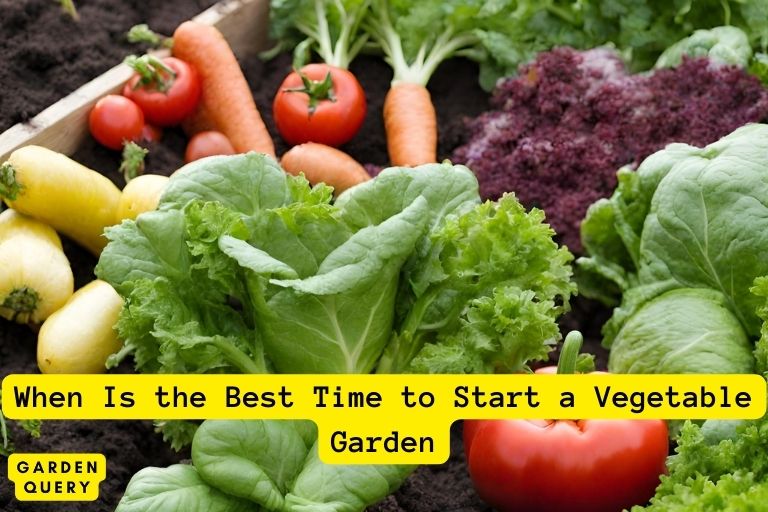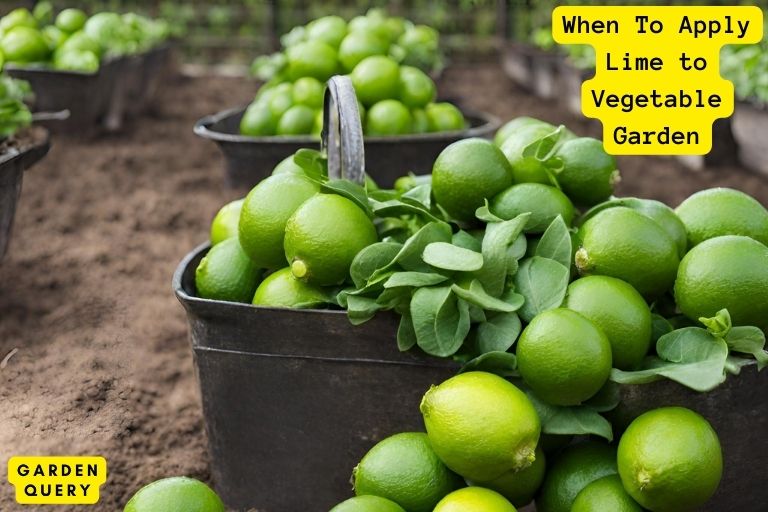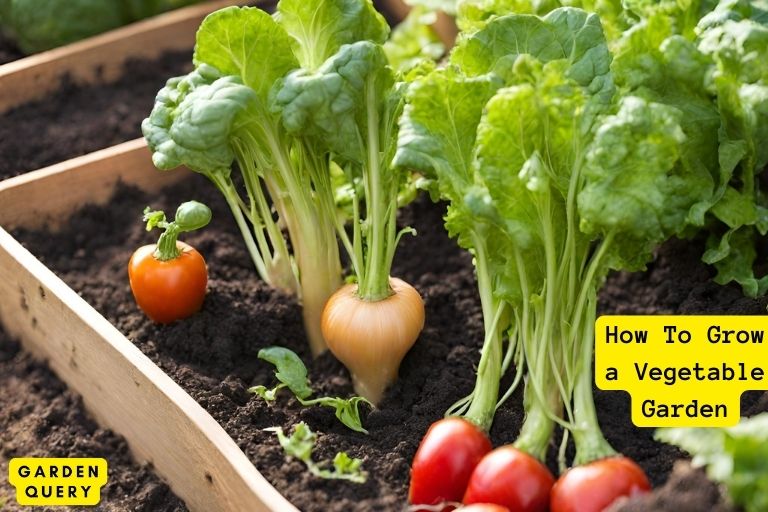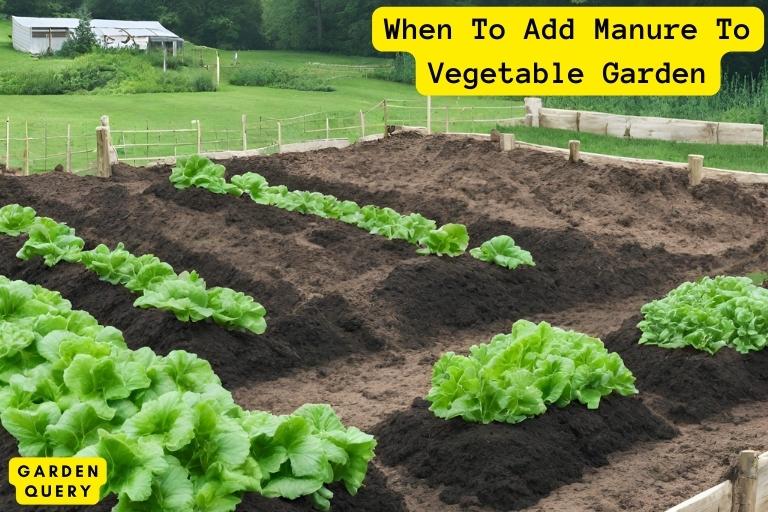When Is the Best Time to Start a Vegetable Garden? Mystery!
The best time to start a vegetable garden is in the early spring, typically between March and April, when the soil has thawed and temperatures are mild enough for most vegetables to thrive.
Introduction
Starting a vegetable garden can be a rewarding and fulfilling experience. Not only does it provide you with fresh and nutritious produce, but it also allows you to connect with nature and cultivate a sense of self-sufficiency. However, timing plays a crucial role in the success of your vegetable garden. The best time to start a vegetable garden depends on various factors, including your location, climate, and the types of vegetables you want to grow.

Benefits of Starting a Vegetable Garden
Before diving into the timing aspect, it’s important to understand the benefits of starting a vegetable garden. Firstly, it allows you to have control over the quality and safety of your food. By growing your own vegetables, you can ensure they are free from harmful pesticides and chemicals. Secondly, gardening provides a physical and mental health boost. The act of planting, caring for, and harvesting vegetables can be a therapeutic and stress-relieving activity. Additionally, spending time outdoors and being in close contact with nature has been proven to have numerous health benefits.
Importance of Timing in Vegetable Gardening
Timing is critical in vegetable gardening because it determines the success of your crops. Different vegetables have different temperature and sunlight requirements, and planting them at the right time ensures optimal growth and yield. Some vegetables, like peas and lettuce, prefer cooler temperatures and can be planted as early as spring. On the other hand, heat-loving vegetables such as tomatoes and peppers thrive in warmer temperatures and should be planted after the last frost date.
It’s important to research the specific planting windows for each vegetable you want to grow in your region. The USDA Plant Hardiness Zone Map is a helpful resource that provides information on the average annual minimum winter temperatures in different areas. Consulting this map can guide you in determining the best time to start your vegetable garden.
In conclusion, the best time to start a vegetable garden depends on various factors such as location, climate, and the types of vegetables you plan to grow. By understanding the unique requirements of each vegetable and considering your local climate, you can ensure that your plants have the best possible chance of thriving. So, start planning and prepare your garden beds accordingly to enjoy the bountiful harvest of homegrown vegetables.
Spring
When it comes to starting a vegetable garden, spring is the ideal time for many gardeners. The warmer temperatures and longer days provide the perfect conditions for seedlings to thrive. Here are some advantages of starting a vegetable garden in spring and a list of recommended vegetables for spring planting.
Advantages of Starting a Vegetable Garden in Spring
- Optimal Growing Conditions: Spring offers the right balance of warmth and moisture for seeds to germinate and plants to grow. The soil is also easier to work with, making it easier to prepare the garden beds.
- Extended Growing Season: By starting your vegetable garden early in spring, you can take advantage of the longer growing season. This means more time for your plants to mature and produce a bountiful harvest.
- Availability of Seedlings: Many garden centers and nurseries stock a wide variety of vegetable seedlings in spring. This saves you time and effort as you can purchase healthy, young plants ready to be transplanted into your garden.
Recommended Vegetables for Spring Planting
Here are some vegetables that thrive when planted in the spring:
- Lettuce: Lettuce varieties such as romaine, leaf lettuce, and butterhead lettuce are perfect for spring planting. They prefer cooler temperatures and can be harvested when they are young and tender.
- Carrots: Carrots are a popular root vegetable that can be grown in spring. They require loose, well-draining soil, and their sweet flavor is enhanced by the cool temperatures of early spring.
- Tomatoes: While tomatoes are technically a warm-season crop, starting them indoors from seed in early spring can give them a head start. Transplant the seedlings outdoors when all frost has passed.
- Peas: Peas can be planted directly into the garden in early spring. They are fast-growing and can tolerate cooler temperatures. Harvest the delicious, sweet pods when they are young and tender.
- Radishes: Radishes are quick-growing vegetables that can be sown directly into the soil in early spring. They are a great choice for beginners as they are low-maintenance and provide a fast harvest.
Remember to consult your local agricultural extension office or a trusted gardening resource for specific planting dates and recommended varieties for your region.
Starting a vegetable garden in spring can be a rewarding and enjoyable experience. It allows you to make the most of the favorable growing conditions and enjoy a fresh harvest throughout the summer months. So, grab your gardening tools and start planting your favorite vegetables this spring!
Summer
Starting a vegetable garden in the summer has several benefits. The warm weather and longer days provide optimal growing conditions for many vegetables. Here are the benefits of starting a vegetable garden in summer:
1. Abundant sunlight: During the summer months, sunlight is plentiful, which is essential for photosynthesis, the process by which plants convert sunlight into energy. The longer days allow plants to receive more sunlight, resulting in better growth and higher yields.
2. Faster growth: With the warm temperatures of summer, plants tend to grow faster. This means you can enjoy fresh vegetables from your garden in a shorter amount of time.
3. Increased variety: Many vegetables thrive in the heat of summer. Crops like tomatoes, cucumbers, peppers, and beans prefer warm weather and will produce abundant yields during this season.
4. Pest control: Summer brings along beneficial insects like ladybugs and bees, which help with pollination and control harmful pests. The warmer temperatures also make it less favorable for certain pests, reducing the risk of infestations.
Recommended Vegetables for Summer Planting
If you’re considering starting a vegetable garden in the summer, here are some vegetables that are well-suited for planting during this season:
- Tomatoes: A summer garden staple, tomatoes thrive in the heat and produce flavorful fruits.
- Cucumbers: These refreshing vegetables love the warmth and can be grown for fresh eating or pickling.
- Peppers: Whether you prefer sweet or spicy, peppers such as bell peppers, jalapenos, and chili peppers are perfect for summer gardens.
- Beans: Green beans and pole beans are fast-growing and produce bountiful harvests in warm weather.
- Zucchini: This versatile summer squash grows quickly and can be used in a variety of dishes.
- Herbs: Many herbs like basil, mint, and thyme thrive in the summer and can add flavor to your cooking.
Remember to provide proper care and maintenance for your vegetable garden, including regular watering, fertilizing, and pest management.
Starting a vegetable garden in the summer can be a rewarding experience. Not only will you enjoy the freshest produce, but you’ll also have the satisfaction of growing your own food. So grab your gardening tools and get started on creating a lush and productive garden this summer!
Fall
Starting a vegetable garden in the fall has several advantages. First and foremost, the cooler temperatures in fall are ideal for certain vegetable crops. Additionally, starting a garden in the fall allows you to extend the growing season and enjoy fresh produce for a longer period.
Advantages of Starting a Vegetable Garden in Fall:
- Cooler Weather: Fall weather is generally cooler, which is favorable for growing cool-season crops such as lettuce, spinach, kale, and broccoli. These vegetables thrive in cooler temperatures and often produce higher quality and tastier yields when grown in the fall.
- Less Pest and Disease Pressure: Many garden pests and diseases are less active in the fall, reducing the risk of damage to your plants. This means less time spent dealing with pest control and more time enjoying your garden.
- Less Watering: In many regions, fall often sees more rain and less evaporation compared to summer months. This means you will spend less time watering your garden and can rely more on natural rainfall.
- Less Weeds: Weeds tend to be less aggressive in the fall, allowing your vegetable plants to thrive without competition for water, nutrients, and sunlight.
Recommended Vegetables for Fall Planting:
When starting a vegetable garden in the fall, consider planting the following vegetables:
- Lettuce: Varieties like romaine, butterhead, and leaf lettuce grow well in cooler temperatures.
- Spinach: This nutrient-rich leafy green is ideal for fall planting as it can tolerate light frosts.
- Broccoli: Fall is the perfect time to grow broccoli, as it thrives in cooler weather and produces delicious heads.
- Carrots: These root vegetables grow well in the fall and can be harvested throughout the season.
- Radishes: Quick-growing radishes can be planted in the fall for a harvest within a few weeks.
- Cabbage: With its dense, leafy heads, cabbage is a popular vegetable for fall gardens.
Remember to check your specific climate and growing zone to determine the best time to start your fall vegetable garden. Planning and preparation are key to a successful harvest.
Starting a vegetable garden in the fall is a great way to make the most of the growing season and enjoy fresh, homegrown produce. Whether you’re a seasoned gardener or a beginner, starting a fall garden can be a rewarding and enjoyable experience. So grab your gardening tools and get ready to sow the seeds of a bountiful fall harvest!
Winter
When it comes to starting a vegetable garden, many people think of spring as the ideal time. However, winter can also be a great time to get started. In fact, there are several benefits to starting a vegetable garden during the winter season.
1. Benefits of Starting a Vegetable Garden in Winter: Starting a vegetable garden in winter allows you to take advantage of the dormant period for many plant species. This means that you can prepare the soil, plan your garden layout, and start seeds indoors without the rush of the spring planting season. Additionally, winter gardening can provide a therapeutic and fulfilling activity during the colder months, helping to beat the winter blues.
2. Recommended Vegetables for Winter Planting: While not all vegetables thrive in the winter, there are several that can withstand the cold temperatures and produce a bountiful harvest. Some recommended vegetables for winter planting include leafy greens like kale, spinach, and lettuce, as well as root vegetables like carrots, radishes, and beets. These vegetables can handle the colder temperatures and even benefit from a touch of frost, which can enhance their flavor.
If you’re interested in starting a winter vegetable garden, it’s important to consider the specific planting dates and requirements for each vegetable. Some vegetables may require protective measures like row covers or cold frames to provide additional insulation from the elements. It’s always a good idea to consult local gardening resources or consult with an experienced gardener for advice on specific winter gardening techniques in your region.
Starting a vegetable garden in winter can be a rewarding and productive endeavor. Not only can you enjoy fresh, homegrown produce during the colder months, but you can also get a head start on your gardening plans for the upcoming spring. So, don’t let the winter weather discourage you from pursuing your gardening dreams. Take advantage of the benefits and opportunities that winter gardening has to offer.
Considerations for Your Region
When it comes to starting a vegetable garden, the timing can vary depending on your climate and region. Factors such as temperature, frost dates, and growing seasons play a crucial role in determining the best time to start planting. Here are some important considerations based on your climate and region:
- Temperature: Different vegetables have different temperature requirements for germination and growth. Some vegetables, like tomatoes and peppers, thrive in warm weather, while others, like lettuce and spinach, prefer cooler temperatures. Understanding the temperature preferences of the vegetables you want to grow will help you determine the best time to start your garden.
- Frost Dates: Frost dates indicate the average date of the last frost in spring and the first frost in fall. It’s essential to know your region’s frost dates, as most vegetables are sensitive to frost and can be damaged or killed by freezing temperatures. Starting your garden too early can risk exposing your plants to late frosts, while starting too late may result in a shorter growing season.
Best Time to Start a Vegetable Garden in Different Regions
The best time to start a vegetable garden can vary depending on your region. Here are some general guidelines for different regions:
- Northern Regions: In northern regions with shorter growing seasons and colder climates, it’s best to start vegetable gardening in late spring or early summer, after the last frost date. This will ensure that the soil has warmed up sufficiently for optimal seed germination and plant growth.
- Southern Regions: Southern regions with longer growing seasons and milder winters offer more flexibility in planting times. In these regions, you can start your vegetable garden earlier in the spring, around late winter or early spring, to take advantage of the extended growing season.
- Coastal Regions: Coastal regions often have more moderated temperatures and can support year-round vegetable gardening. However, it’s still important to consider the specific temperature requirements of each vegetable and adjust planting times accordingly.
- Mountainous Regions: Mountainous regions tend to have cooler temperatures and shorter growing seasons. It’s recommended to start vegetable gardening in late spring or early summer, depending on the specific altitude and climate conditions of your mountainous region.
Remember to research specific vegetables’ preferred growing conditions, including temperature, sunlight, and soil requirements, to ensure a successful and bountiful vegetable garden in your region.
By considering your climate, frost dates, and regional characteristics, you can determine the best time to start a vegetable garden in your area and maximize your chances of a successful harvest. Happy gardening!
Succession Planting
When it comes to vegetable gardening, succession planting is a technique that can help you maximize your harvests throughout the growing season. Succession planting involves planting different crops or planting the same crop at staggered intervals to ensure a continuous supply of fresh produce. This technique is especially useful for short-season climates or areas with unpredictable weather.
Understanding Succession Planting in Vegetable Gardening
Succession planting allows you to make the most of your garden space and extend the growing season. By planting crops in succession, you can ensure a steady supply of vegetables and avoid a surplus of produce all at once. It also helps prevent pests and diseases from taking hold since not all of your crops will be at the same stage of growth at any given time.
To implement succession planting, you need to plan your garden carefully and know the growth cycle of different vegetables. Some crops, such as lettuce and radishes, have a shorter harvest window and can be planted multiple times throughout the growing season. Other vegetables, like tomatoes and peppers, have a longer maturation period and may only need to be planted once.
Tips for Maximizing Harvests with Succession Planting
Here are some tips to help you make the most of succession planting in your vegetable garden:
- Start by creating a planting schedule: Determine the average frost dates in your area and plan your planting schedule accordingly. This will help you determine when to start each crop and when to sow additional seeds or transplant seedlings.
- Choose crops with different maturity dates: Opt for vegetables that have varying maturation times. This way, you can stagger your plantings and ensure a continuous harvest throughout the season.
- Utilize empty spaces wisely: As you harvest crops or remove mature plants, use the empty space to plant new seeds or transplant young seedlings. This will allow you to maximize the productivity of your garden beds and reduce wasted space.
- Consider interplanting: Interplanting involves planting different crops in the same row or bed. By pairing plants with different growth habits or nutrient requirements, you can optimize space and increase productivity.
Remember to keep track of your planting dates and harvest times to help you plan future successions. With proper planning and implementation, succession planting can result in a bountiful and continuous harvest from your vegetable garden.
So, whether you’re a seasoned gardener or just starting out, consider incorporating succession planting into your vegetable garden to enjoy a steady supply of fresh produce throughout the growing season.
Conclusion
When it comes to starting a vegetable garden, timing is crucial for a successful harvest. The best time to start your vegetable garden depends on various factors, including your location, local climate, and the types of vegetables you want to grow.
To determine the best time, consider the last frost date in your area. This information can be found through online resources or by consulting your local agricultural extension office. Starting your garden after the threat of frost has passed will give your plants a better chance of thriving.
Additionally, understanding the temperature requirements of different vegetables is essential. Some vegetables, like peas and spinach, prefer cooler temperatures and can be planted as early as spring. On the other hand, warm-season vegetables like tomatoes and peppers thrive in warmer weather, so it’s best to wait until the soil has had a chance to warm up in late spring or early summer.
Here are some key points to remember for successful vegetable gardening:
- Prepare the soil: Make sure you have well-draining soil with adequate organic matter for optimal plant growth. Consider adding compost or other soil amendments to improve fertility.
- Choose the right location: Select a spot in your garden that receives at least 6-8 hours of sunlight per day and has access to water for irrigation.
- Plan your garden layout: Take into consideration the space requirements of different vegetable varieties and plan accordingly. Proper spacing will promote airflow and reduce the risk of disease.
- Start with easy-to-grow vegetables: If you’re new to gardening, start with vegetables that are relatively low maintenance and forgiving, such as tomatoes, lettuce, or beans.
- Practice proper watering and maintenance: Water your plants regularly, providing enough moisture without overwatering. Weed regularly to prevent competition for nutrients and space.
Remember, gardening is a continuous learning process. Don’t be discouraged by setbacks or failures. With time and experience, you’ll develop a green thumb and enjoy the rewards of a bountiful vegetable garden.
Happy gardening!
- Best Therapists In Dallas - February 1, 2024
- Holly Willoughby Husband: Holly Willoughby’s Love Story - January 30, 2024
- Holly Willoughby Dress: 5 Style Secrets and 7 Must-Know Career Milestones - January 30, 2024





